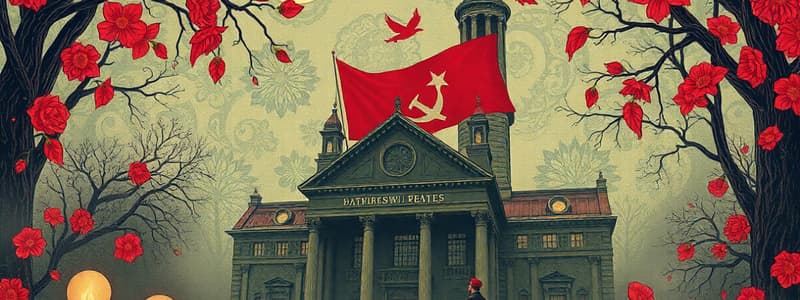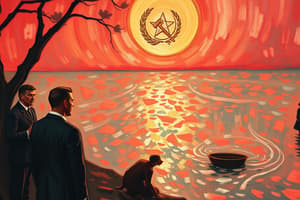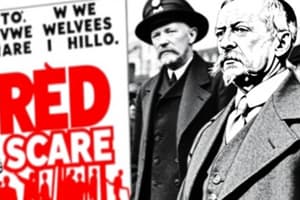Podcast
Questions and Answers
Which action taken during the Red Scare era was directly aimed at government employees?
Which action taken during the Red Scare era was directly aimed at government employees?
- The Rosenberg Case
- The Loyalty Review Board investigations (correct)
- The Smith Act prosecutions
- The McCarran Internal Security Act
How did McCarthy's tactics contribute to the political climate of the Red Scare?
How did McCarthy's tactics contribute to the political climate of the Red Scare?
- By ensuring fair trials for accused communists
- By promoting bipartisan cooperation in Congress
- By discouraging public discourse on communism
- By using unsupported accusations to gain political power (correct)
How did the Army-McCarthy hearings impact Senator Joseph McCarthy's influence?
How did the Army-McCarthy hearings impact Senator Joseph McCarthy's influence?
- They exposed him as a bully and led to his censure. (correct)
- They led to his appointment as head of the Senate Armed Services Committee.
- They resulted in increased public support for his anti-communist efforts.
- They solidified his control over Congressional investigations.
Which of the following best describes the impact of the Red Scare on artistic expression?
Which of the following best describes the impact of the Red Scare on artistic expression?
What was the significance of the Dennis v. U.S. Supreme Court case during the Red Scare?
What was the significance of the Dennis v. U.S. Supreme Court case during the Red Scare?
What was a key provision of the McCarran Internal Security Act of 1950?
What was a key provision of the McCarran Internal Security Act of 1950?
What was the ultimate impact of the Red Scare on the perceived threat of communist takeover in the United States?
What was the ultimate impact of the Red Scare on the perceived threat of communist takeover in the United States?
How did the end of the Korean War impact the Red Scare in the United States?
How did the end of the Korean War impact the Red Scare in the United States?
What can be inferred from the fact that the ACLU defended First Amendment rights for Communist Party members during the Red Scare?
What can be inferred from the fact that the ACLU defended First Amendment rights for Communist Party members during the Red Scare?
What critical perspective did artists like Shirley Jackson and Arthur Miller offer during the Red Scare?
What critical perspective did artists like Shirley Jackson and Arthur Miller offer during the Red Scare?
Flashcards
Loyalty Review Board (1947)
Loyalty Review Board (1947)
Established to assess the loyalty of federal employees during the Red Scare.
Smith Act Prosecutions
Smith Act Prosecutions
Prosecutions under this act jailed Communist Party leaders for advocating government overthrow.
McCarran Internal Security Act (1950)
McCarran Internal Security Act (1950)
Made advocating totalitarian government unlawful and restricted the activities of Communist-front groups.
House Un-American Activities Committee (HUAC)
House Un-American Activities Committee (HUAC)
Signup and view all the flashcards
Hiss Case (1948)
Hiss Case (1948)
Signup and view all the flashcards
Rosenberg Case (1953)
Rosenberg Case (1953)
Signup and view all the flashcards
Joseph McCarthy's Rise and Fall
Joseph McCarthy's Rise and Fall
Signup and view all the flashcards
Employment Act of 1946
Employment Act of 1946
Signup and view all the flashcards
GI Bill (Servicemen's Readjustment Act, 1944)
GI Bill (Servicemen's Readjustment Act, 1944)
Signup and view all the flashcards
New Frontier
New Frontier
Signup and view all the flashcards
Study Notes
Loyalty Review Board (1947)
- The Truman administration investigated over 3 million federal employees.
- Thousands of federal employees resigned or were terminated between 1947 and 1951.
Smith Act Prosecutions
- American Communist Party leaders were jailed for advocating government overthrow.
- Dennis v. U.S. (1951) resulted in the Supreme Court upholding the Smith Act's constitutionality.
McCarran Internal Security Act (1950)
- Advocating a totalitarian government was made unlawful by this Act.
- The Act restricted employment and travel for members of Communist-front groups.
- It authorized the establishment of subversive detention camps.
House Un-American Activities Committee (HUAC)
- HUAC investigated Communism in government, the Boy Scouts, and Hollywood.
- Individuals who refused to testify before HUAC were often tried or blacklisted.
Cultural Impact of Anti-Communism
- Films, plays, and writers like Arthur Miller faced scrutiny and attacks.
- Loyalty oaths became a requirement for employment in particular sectors.
- The ACLU defended First Amendment rights for Communist Party members.
Artist Responses to Anti-Communism
- Shirley Jackson's "The Lottery" (1948) critiqued blind conformity.
- Lillian Hellman was blacklisted for refusing to testify before HUAC.
- Arthur Miller's "The Crucible" (1953) critiqued anti-Communist persecution.
Espionage Cases
- Fear of Communist espionage was heightened by actual spy cases.
- Alger Hiss was convicted of perjury in the Hiss Case (1948) and linked to Communist espionage.
- Julius and Ethel Rosenberg were executed for espionage in 1953 after a controversial trial.
Joseph McCarthy's Rise
- McCarthy claimed to possess a list of 205 Communists working in the State Department in 1950.
- McCarthy gained political power through sensational and unproven accusations.
McCarthy's Tactics
- He used unsupported accusations to undermine the Truman administration.
- He gained popularity with working-class Americans, but damaged the Democratic Party.
Army-McCarthy Hearings (1954)
- McCarthy was exposed as a bully during televised hearings concerning Communist infiltration in the army.
- The Senate censured McCarthy in December 1954.
Decline of the Red Scare
- The Red Scare diminished because the threat of a Communist takeover was seen as exaggerated.
- Eisenhower and other leaders played a key role in shifting the political discourse.
- A booming economy in the 1950s, following the Korean War armistice, shifted the focus.
Harry S. Truman's Presidency (1945-1953)
- Employment Act of 1946 established the Council of Economic Advisers, aiming to promote full employment, but faced resistance.
- The GI Bill (Servicemen's Readjustment Act, 1944) aided 15 million veterans in transitioning with education, home loans, and business support, White veterans were favored over Black ones.
- The Baby Boom (1945-1960) led to an increased birthrate of 50 million babies and the entry of women into the workforce (1/3 of married women worked by 1960).
- Suburban Growth, symbolized by Levittown (17,000 homes), offered affordable suburban living, yet excluded African Americans through segregation.
- The Rise of the Sun Belt was a product of economic opportunities in defense and warmer climates, which drove migration to Southern and Western states.
- Inflation and Strikes involved postwar inflation surging to 25%, This led to over 4.5 million strikes in 1946, prompting Truman's intervention.
- Republican Congress (1946) ensued Republican control which led to tax cuts for the wealthy and the Taft-Hartley Act, which limited union power.
- Election of 1948: Truman defied expectations, defeating Dewey and securing a decisive win.
- Fair Deal (1949) saw Proposed reforms blocked by conservatives, but minimum wage and Social Security expansions were passed.
Eisenhower's Presidency (1953-1961)
- Modern Republicanism sought balanced budgets, expanded New Deal programs (Social Security, minimum wage), and the creation of the Department of Health, Education, and Welfare.
- Interstate Highway System (1956): Authorized 42,000 miles of highways, which boosted defense, the economy, and suburbanization.
- The Postwar Prosperity era saw strong economic growth, low inflation (1.5%), and a tripled per-capita income between 1945 and 1960.
John F. Kennedy's Presidency (1961-1963)
- New Frontier: Kennedy faced challenges passing his domestic agenda (education, healthcare, civil rights), but achieved successes in trade and defense spending.
- Economic Growth: tariff reductions with European nations and defense spending stimulated the economy.
Lyndon B. Johnson's Presidency (1963-1969)
- Great Society: expanded on civil rights, education, healthcare, and poverty reduction, with substantial social reforms (Medicare, Civil Rights Act of 1964).
- Economic Expansion ensued with tax cuts boosting consumer spending and economic growth.
Richard Nixon's Presidency (1969-1974)
- New Federalism involved shifting responsibility for social programs to state and local governments through revenue sharing.
- Stagflation occurred when Nixon faced inflation and recession; imposing wage/price controls, taking the dollar off the gold standard, and raising tariffs on imports.
Gerald Ford (1974-1977) & Jimmy Carter (1977-1981)
- Ford's Efforts on Inflation intended to encourage voluntary measures to curb inflation, however, the economy worsened with high unemployment.
- Carter's Struggles with Inflation ensued because in 1979-1980, inflation hit 13%, despite efforts to reduce energy consumption and regulate inflation.
- Volcker's High-Interest Rates saw the Fed chairman raising interest rates to curb inflation, resulting in a severe recession but reducing inflation by 1982.
Economic Shift in the 1970s
- The Post-WWII economy weakened as global competition grew (e.g., Japan, Germany); new technology reduced high-paying manufacturing jobs.
- The U.S. began to experience a decline in living standards for the first time since the war.
Consumer Culture and Conformity
- Television: By 1961, there was approximately 1 TV set per 3.3 Americans. Shows, like Leave It to Beaver reinforced suburban, white, middle-class values.
- Advertising: Aggressive marketing across media promoted materialism; the rise of shopping centers, credit cards, and fast food chains followed.
- Books & Music: Paperback books surged in popularity; rock and roll (e.g., Elvis) became popular among youth.
- Corporate America: Domination occurred by conglomerates, white-collar jobs, and corporate conformity (e.g., “Organization Man").
- Religion: There was a Post-WWII expansion of religious affiliations, the focus on identity and socializing, as seen in Protestant, Catholic, Jew (1955).
Women's Roles
- Homemaking was reinforced by the Baby boom and suburban life, thereby reinforcing traditional homemaker roles, which were promoted by Dr. Benjamin Spock's book.
- Workforce Entry saw more women working, but they faced being seen as wives/mothers, earning lower wages.
Social Critics
- David Riesman critiqued the society's shift from “inner-directed” to “other-directed" individuals (The Lonely Crowd, 1958).
- John Kenneth Galbraith criticized wealthy Americans that were ignoring societal needs (The Affluent Society, 1958).
- C. Wright Mills warned of corporate dehumanization (White Collar, 1951) and threats to freedom (The Power Elite, 1956).
Novels and Rebellion
- Literary Rebellion: The Catcher in the Rye (Salinger, 1951) and Catch-22 (Heller, 1961) critiqued societal conformity.
- Beatniks: Writers like Jack Kerouac and Allen Ginsberg rebelled against societal norms, advocating spontaneity and drug use.
Assassination and the End of the Postwar Era
- Kennedy Assassination: He was assassinated on Nov. 22, 1963; conspiracy theories questioned the official story.
- This Loss of Trust then marked the beginning of declining trust in government institutions.
In Retrospect
- Legacy ensued where Kennedy's call for public service inspired some, but the Vietnam War and societal tensions led to disillusionment.
- By 1968, Counterculture had replaced the idealism of the 1950s and it was replaced by social and political upheaval.
Studying That Suits You
Use AI to generate personalized quizzes and flashcards to suit your learning preferences.




